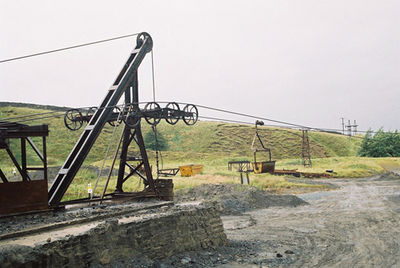Aerial Ropeways: Difference between revisions
No edit summary |
No edit summary |
||
| Line 36: | Line 36: | ||
* Appropedia: [http://www.appropedia.org/Ropeway_in_the_Himalayas Ropeway in the Himalayas] | * Appropedia: [http://www.appropedia.org/Ropeway_in_the_Himalayas Ropeway in the Himalayas] | ||
[[Category: | [[Category:Transport]] | ||
[[Category:Metalworks]] | [[Category:Metalworks]] | ||
Revision as of 19:39, 12 February 2011
Simple, inexpensive yet powerful technology. One of the most energy-efficient forms of transporting goods and people. Relatively easy and quick to set up, operate and take down again. The most common materials used for constructing ropeways were first wood/fiber and then steel/steel ropes. The introduction of steel ropes and electric motors was a major efficiency boost, so these should probably be the preferred option.
Gravity-powered ropeway
In mountainous regions, a ropeway may be powered by gravity alone (see links below, Nepal). This has opened up opportunities for high-volume, low-cost trade between high-altitude mountain communities and low-altitude communities. Costs are fixed, and are dicated only by the cost of the ropeway infrastructure. There are no energy costs. A mountain community may deliver construction materials (e.g. stones, bricks and sand; all with low embodied energy) or minerals. A lower-altitude region may deliver biomass/biofuels to the mountainous region.
Open source ropeway hardware for large-scale biochar transport
Biochar is becoming increasingly recognized as an important soil amendment and strategy to reverse climate change. Some regions of the world, such as the semi-arid drylands, have little capacity for producing biomass and biochar. Other regions, such as forests, produce an abundance of biomass but it is often at risk of wildfires, releasing gigatons of carbon dioxide into the atmosphere as part of the normal carbon cycle. Therefore, the production of biochar in forests has been proposed, followed by transport to nearby biomass-poor regions. If done by ground transport (trucks, rail), this would be prohibitively expensive and would make no sense from an emissions point of view.
Aerial ropeways may change that equation, as they have many qualities needed to transport large amounts of biochar energy-efficiently and inexpensively. The energy released from biochar production (heat) can drive a heat engine that powers the ropeway. Even topsoil could be transported in this way, for rapid regeneration of degraded soils.
Some open source hardware development is needed, and may include:
- very large bins of sheet metal with steel supports (biochar is light-weight and bulky); bins are designed to prevent carbon dust that might explode (need to be covered/closed)
- poles that can be made of steel pipes (for the drylands) or wood (in forests); design for rapid take-down and re-assembly in different location
- steel rope with standardized diameter to be used everywhere
- standardized wheels (possibly sand-cast or CNC-machined ?), i.e. a shape that works well with the size of steel rope chosen
- development of social and financial structures to facilitate these ropeways (i.e. to address NIMBYism by financially including landholders who provide the land)
Example: In the Rocky Mountains, there are billions of tons of dead wood that resulted from pine beetle kills. But turning that wood into biochar and leaving it locally would only make it last until the next wildfire (unless buried deep underground). If this carbon could be transported out into an agricultural area without wildfires, that would keep the carbon out of the atmosphere permanently. Same situation in Siberia, where wildfires release billions of tons of CO2 into the atmosphere every year. What if this carbon could be turned into biochar and then transported to a non-forested area, say in Central Asia or Mongolia ?
Biochar ropeway / refinery integrated system:
- transport biomass on ropeway to a central (small) biorefinery
- pyrolysis and biochar production, liquid fuel production (central small refinery should ideally be located near waterways for further transport, or at least have rail access)
- transport biochar back to the field
- last mile (on/off ramp): cargo bicycle, horsepower, small machines
Urban-rural transport
Modern ropeways could be installed to facilitate urban-rural transport. There is vast potential in re-establishing nutrient cycling systems betweeen country and city. Processed organic waste from the city (compost, humanure, ash) would be be transported back to the country to be used as fertilizer. The process could even be powered by the energy that is still contained in the waste (by heat engine, such as steam engine, biogas-fired turbine, etc.). There could also be farmers' markets and CSA (community supported agriculture) distribution points along the ropeway, selling products from the country to the city.
External Links
- Low-tech Magazine: "Aerial ropeways: automatic cargo transport for a bargain"
- Practical Action: "Technical Information Online Ropeways - Aerial Ropeways in Nepal"
- Appropedia: Aerial Ropeways in Nepal
- Appropedia: Ropeway in the Himalayas

